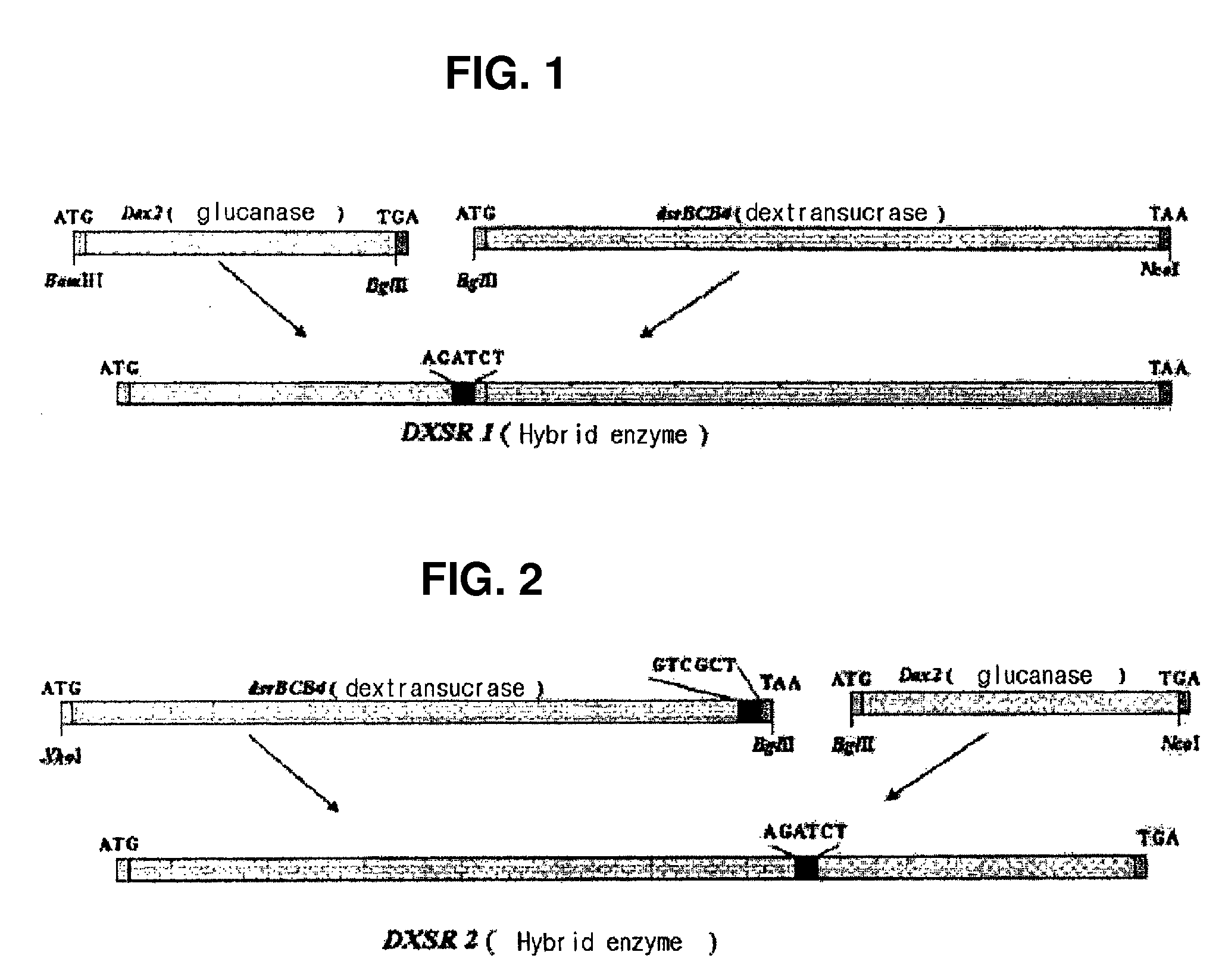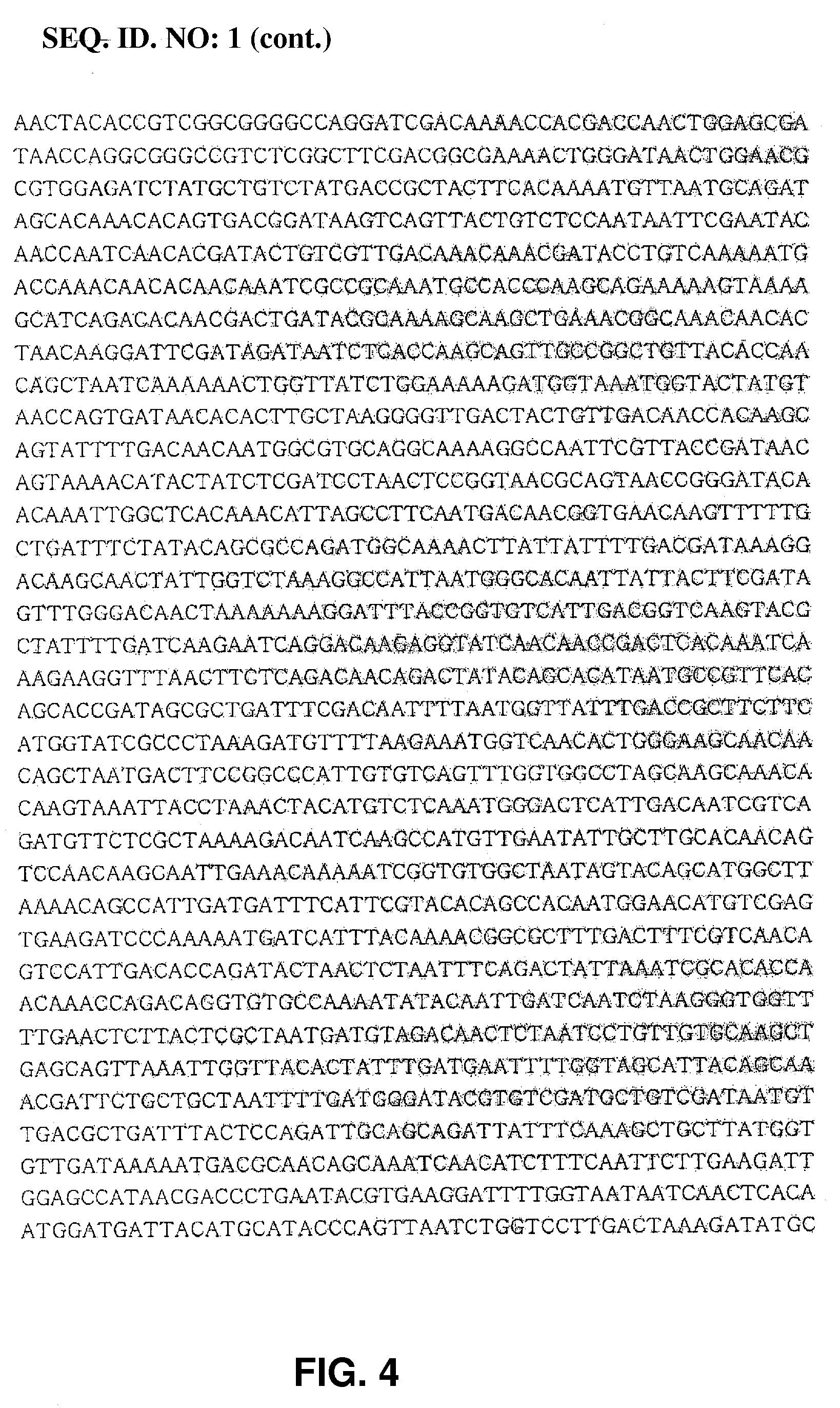Hybrid genes and enzymes of glucanase and dextransucrase and processes for preparing isomalto-oligosaccharides or dextran using the same
a technology which is applied in the field of hybrid genes and enzymes of glucanase and dextran, and to the process of preparing isomalto-oligosaccharides or dextran using the same, can solve the problems of complex cultivation technique, low yield of isomalto-oligosaccharides, and difficult control
- Summary
- Abstract
- Description
- Claims
- Application Information
AI Technical Summary
Problems solved by technology
Method used
Image
Examples
example 1
Preparation of the Hybrid Gene of Glucanase-Dextransucrase
(1) Isolation of Chromosomal DNA Comprising the Genes of Glucanase and Dextransucrase
[0040]Gene dex2 and gene dsrB were isolated from Arthrobacter oxydans KPS (KACC 91140) and Leuconostoc mesenteroides NRRL B-1299 (USDA), respectively, by alkaline lysis method.
[0041]Specifically, Leuconostoc mesenteroides NRRL B-1299 was cultivated in 50 ml of LWS medium [0.5% (w / v) yeast extract, 0.5% (w / v) KH2PO4, 0.02% (w / v) MgSO4-7H2O, 0.001% (w / v) NaCl, 0.001% (w / v) FeSO4-7H2O, 0.001% (w / v) MnSO4-H2O, 0.013% (w / v) CaCl2-2H20], and Arthrobacter oxydans KPS was cultivated in 50 ml of LB medium [0.5% (w / v) yeast extract, 0.5% (w / v) NaCl, 1% trypton], for two days. The cells were harvested by centrifugation at 14000 xg at a temperature of 10° C. for 10 minutes. The cultures of two strains were added to an E-tube, respectively. Cells were then washed with 50 mM Tris-Cl (pH 8.0, 10 mi) and centrifuged at 14000 xg for 2 minutes. The same proced...
example 2
Cultivation of the Cells Transformed with the Hybrid Genes
[0050]The transformed cells comprising the hybrid gene DXSR1, which was obtained from the above step 1(3) were cultivated in LB medium [0.5% (w / v) yeast extract, 0.5% (w / v) NaCl, 1% trypton] supplemented with 2% sucrose and ampicillin (50 βg / βi) at 37° C. for six hours. Then, lactose (1 mM) was added thereto as an activator and the cells were cultivated at 16 ″C for 24 hours. Supernatant obtained from said cell culture and cell lysates obtained by ultra-sonication of said cell culture were used for identification of the enzymatic activity.
example 3
Identification of the Hybrid Enzymes and the Reaction Product
[0051]The components of the supernatant of the cell culture obtained from Example 2 were identified by TLC. The result is shown in FIG. 12. In FIG. 12, lane 1 represents a result for a series of isomalto-oligosaccharides, lane 2 represents a result for sucrose, and lane 3 represents a result for the culture supernatant. As shown in FIG. 12, it was found that isomalto-oligosaccharides, which were degraded from sucrose, were contained in the culture supernatant.
[0052]Furthermore, in order to determine the presence of the hybrid enzymes in the obtained cell lysates, 6% SDS-PAGE electrophoresis was carried out. Specifically, the lysates were subjected to an electrophoresis with electric current of 50 mA on 6% polyacrylamide gel. Upon the completion of the electrophoresis, the gel was stained with a staining solution (Coomassie brilliant blue R-250 of 1 g, acetic acid of 100 mi, methanol of 450 mi and distilled water of 450 mi)...
PUM
| Property | Measurement | Unit |
|---|---|---|
| molecular weight | aaaaa | aaaaa |
| temperature | aaaaa | aaaaa |
| pH | aaaaa | aaaaa |
Abstract
Description
Claims
Application Information
 Login to View More
Login to View More - R&D
- Intellectual Property
- Life Sciences
- Materials
- Tech Scout
- Unparalleled Data Quality
- Higher Quality Content
- 60% Fewer Hallucinations
Browse by: Latest US Patents, China's latest patents, Technical Efficacy Thesaurus, Application Domain, Technology Topic, Popular Technical Reports.
© 2025 PatSnap. All rights reserved.Legal|Privacy policy|Modern Slavery Act Transparency Statement|Sitemap|About US| Contact US: help@patsnap.com



